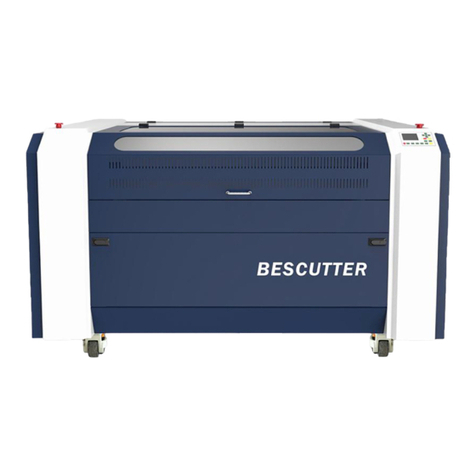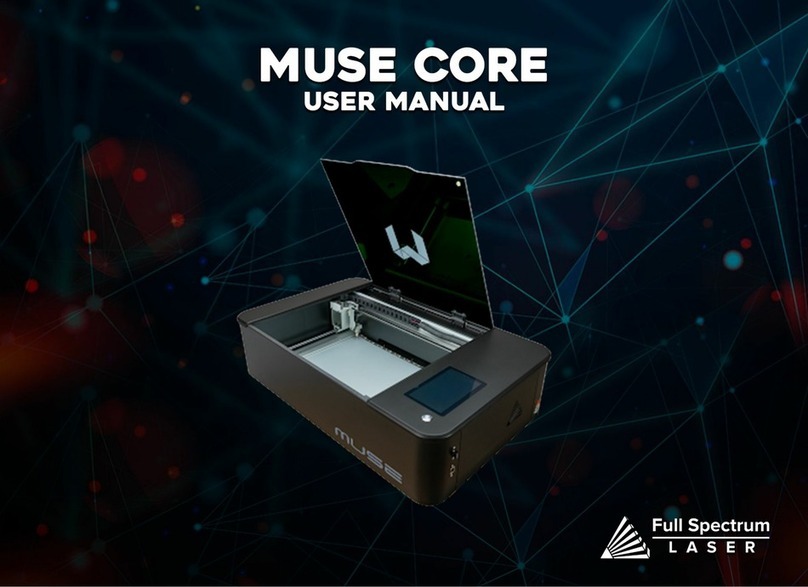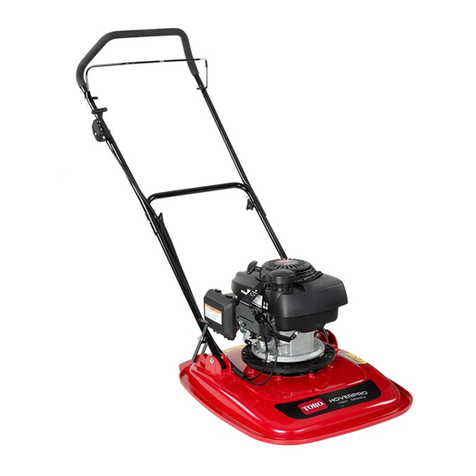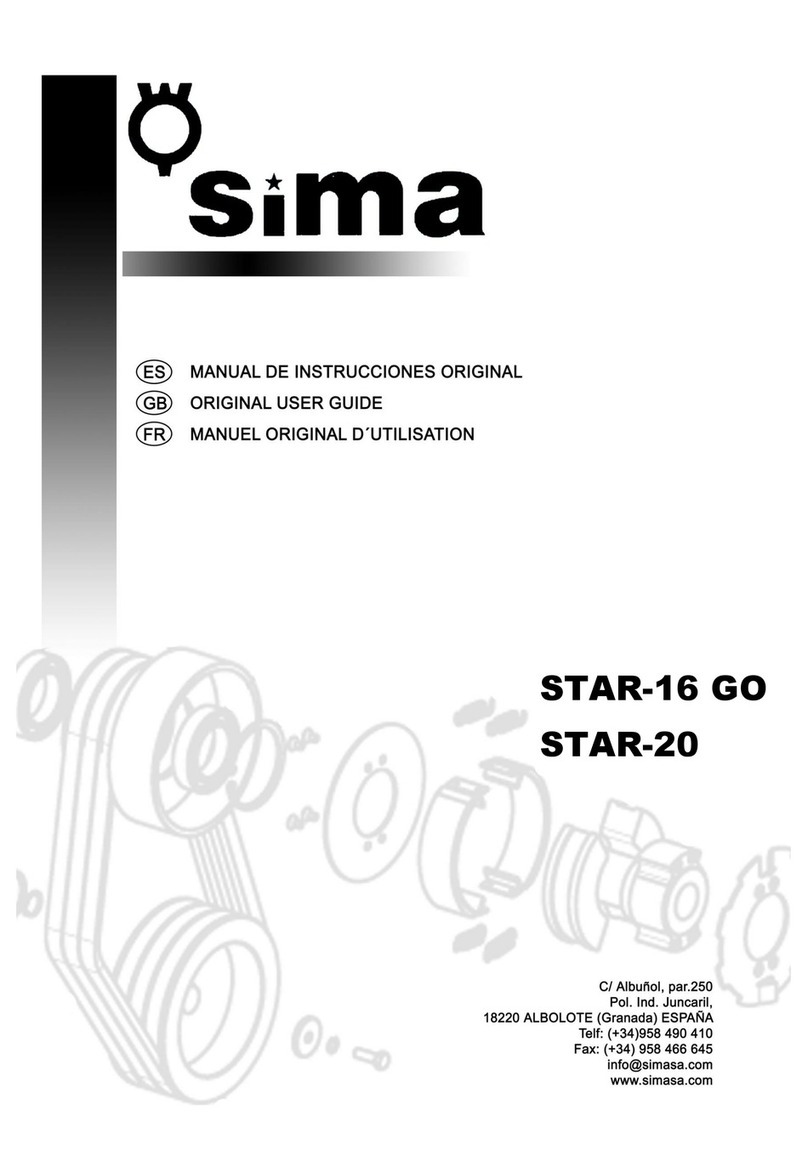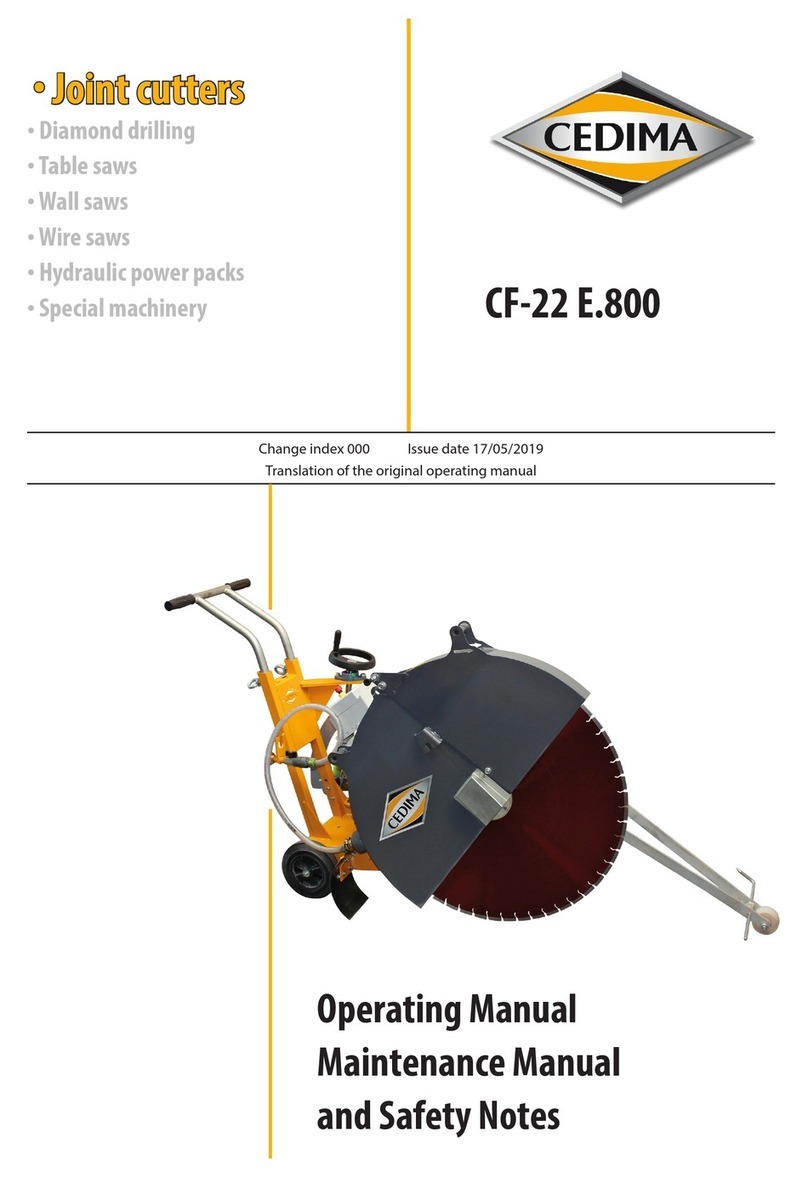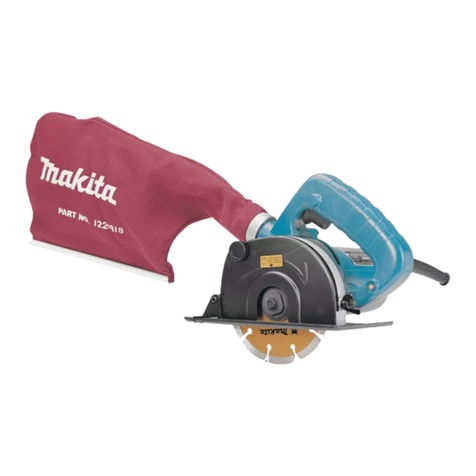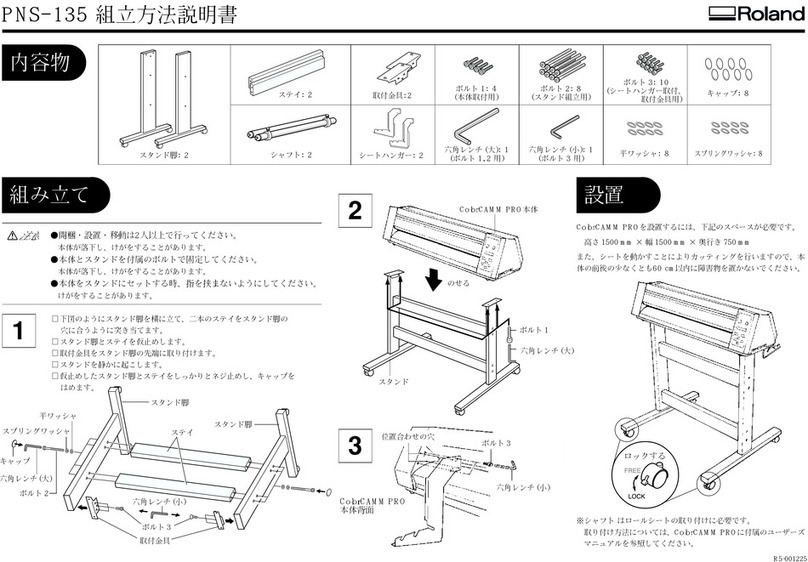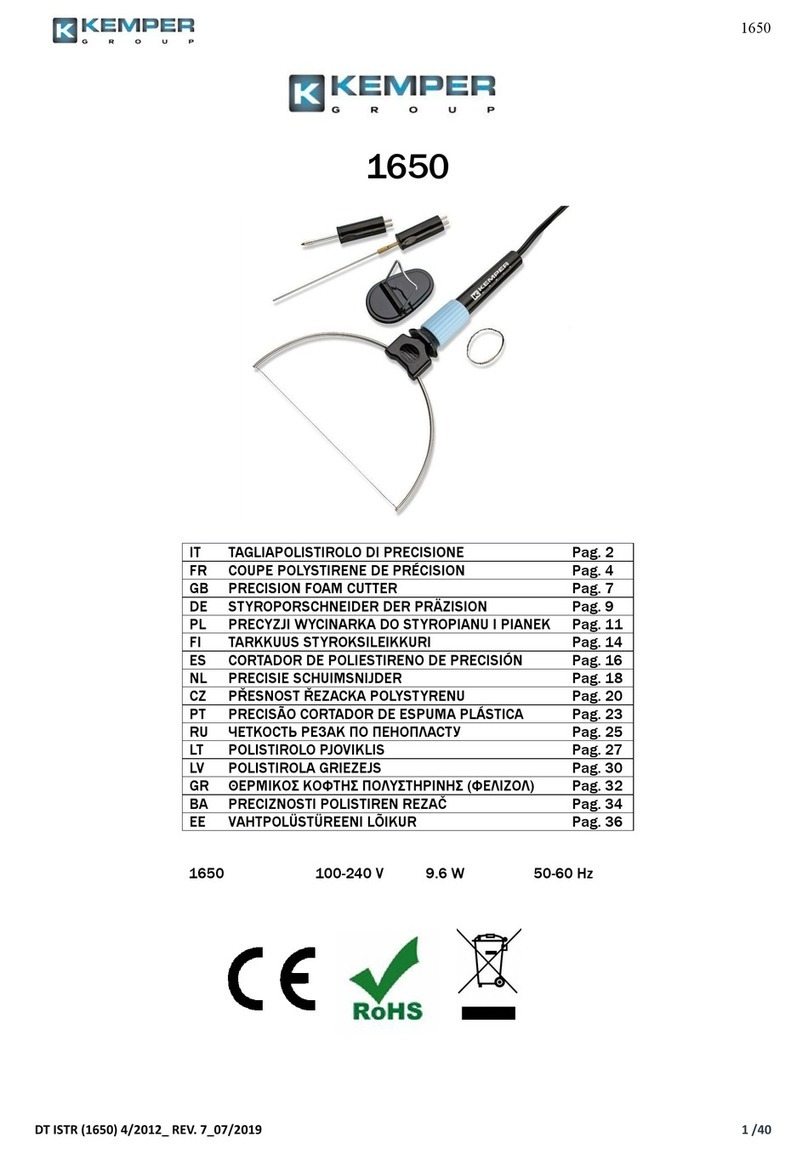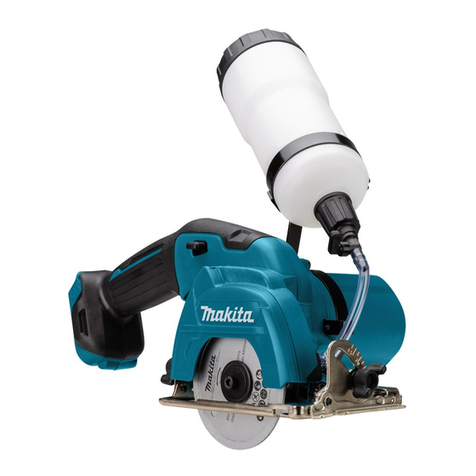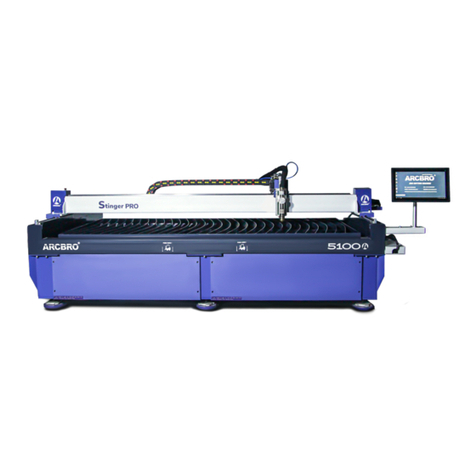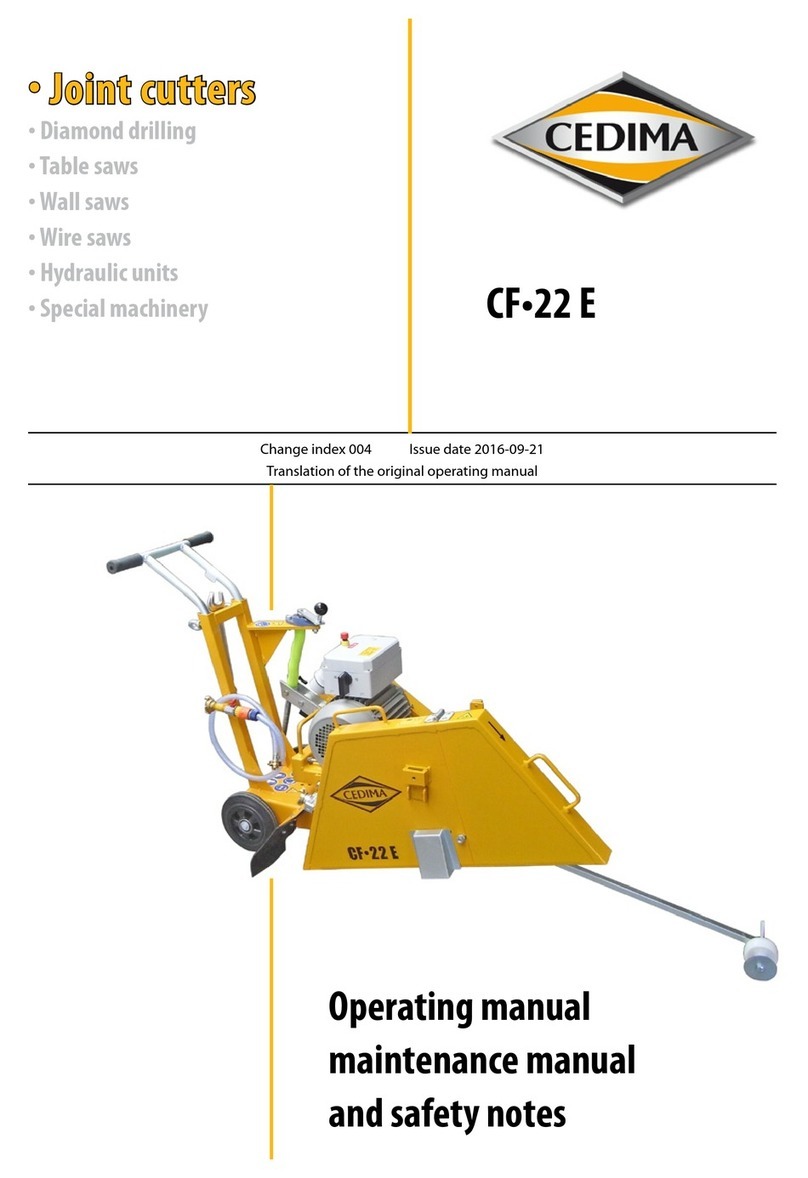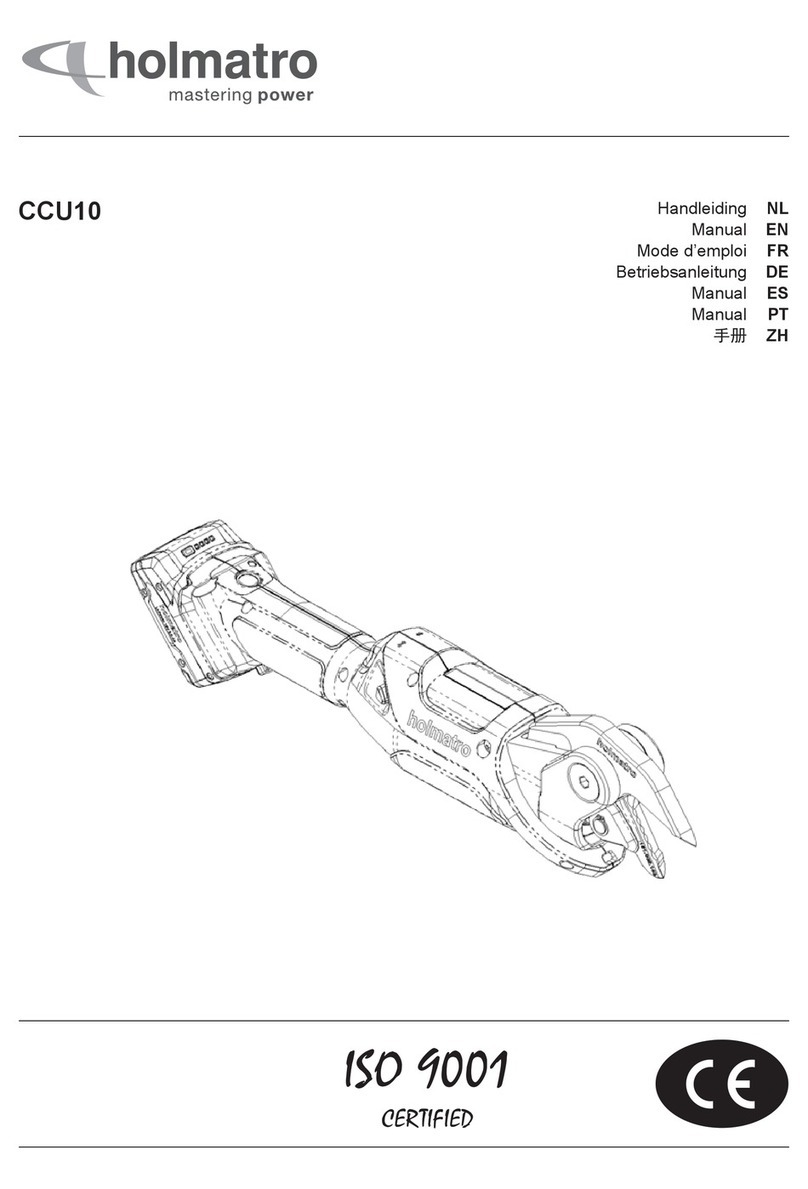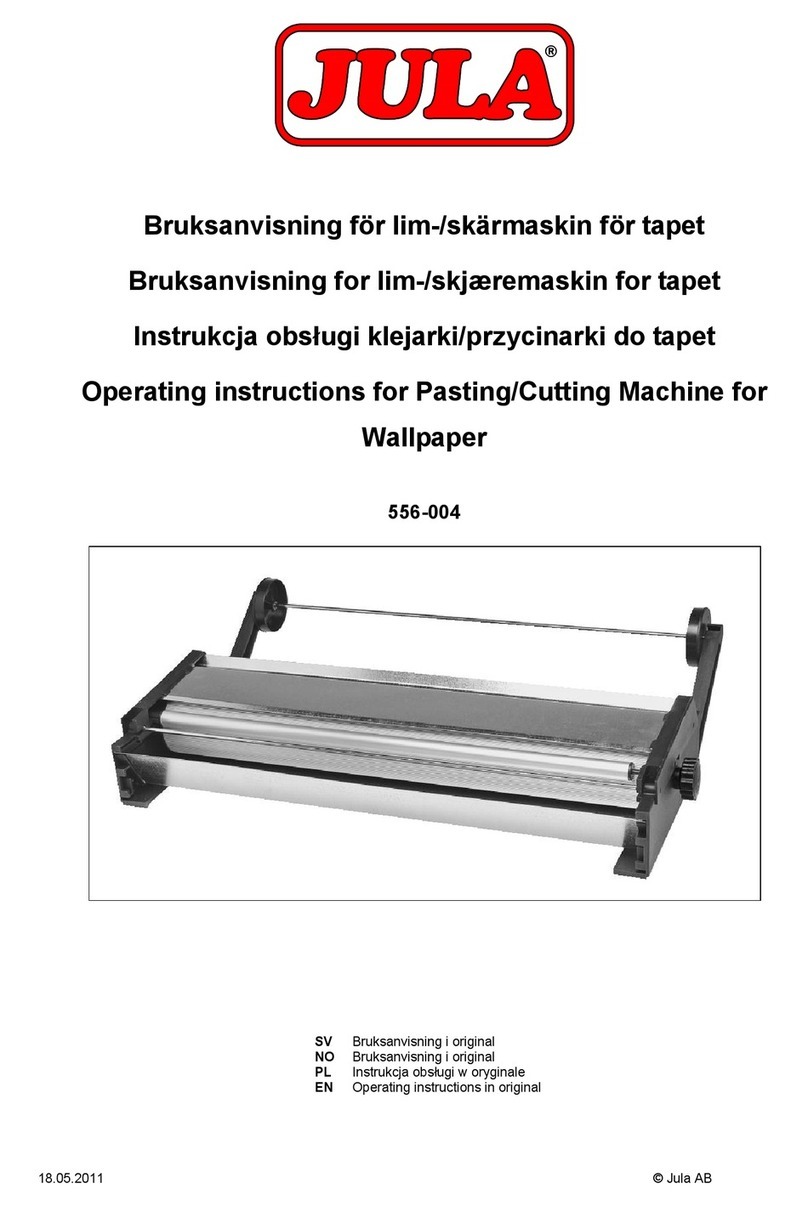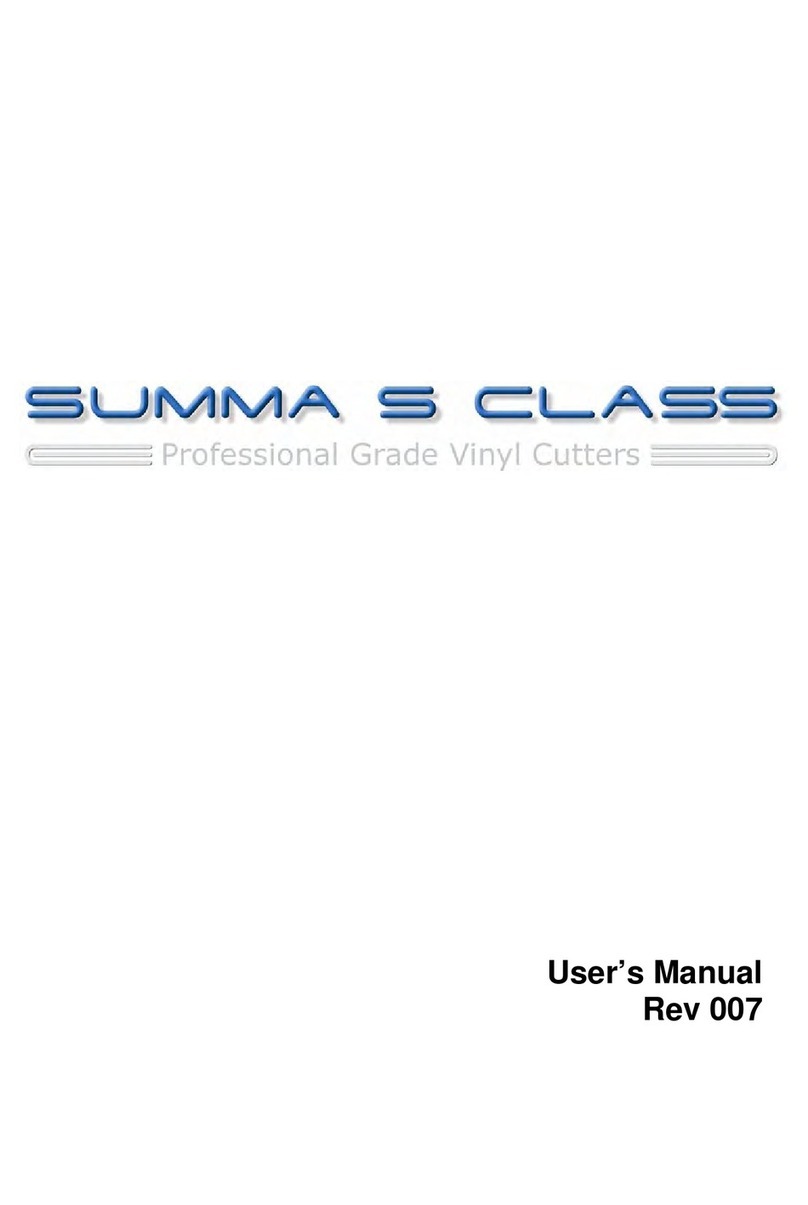BESCUTTER Accu Star User manual

Accu Star
Fiber Laser Cutting Machine Series
Product Manual

Disclaimer and Responsibility Statement
Whole using the machine from our company, users are required to ensure integrity and
independence of the product including but not limited to: mechanical, electrical, optical, control
software and accessories. Unauthorized modification is strictly prohibited. It is a must to satisfy
operating environment and operating specifications specified in the owner’s manual. For the
followings:
1. Machine modified with no authorization (including but not limited to: add, remove, modify,
unauthorized disassembly, replacing parts);
2. Use the machine in the environment failing to satisfy the operating requirements;
3. Operate disobeying the specifications of our company;
4. Unauthorized use the machine parts, accessories and auxiliaries on to other machine or in
other places;
5. Viciously disassemble, destroy, decode hardware and software of the machine from our
company.
Our company shall not undertake any direct, indirect or joint responsibility. Our company reserves
the rights to ascertain legal responsibility for the serious consequences or economic losses or
reputation losses caused by what mentioned above.

Foreword
Thank you for choosing our laser equipment!
Before operating, please read this manual carefully to ensure proper use of your equipment.
Please keep this manual properly for future reference.
Due to different configurations, certain models might not have certain features listed in this manual.
The actual product shall prevail.
Due to constant improvement, certain content of this manual might be inconsistent with the actual
product, which shall prevail.
The symbol conventions in this manual:
Attention
The content requires special attention and the user must abide by, or else it
will cause error or serious problems.
Tip
Prompt the user to pay attention or suggest the user to abide by, which will be
more convenient and efficient.
Alarm
For a particular case there is no dedicated staff to guide the operation could
lead to catastrophic happens.

Safety Precautions
Attention
Before using the machine, users are required to carefully read this manual and other operating
requirements, strictly abide by the operating specifications. Professional are required for
operating the machine.
Alarm
The machine uses class 4 laser (strong laser radiation). The laser radiation may possibly cause the
following accidents:
◆Emblaze the surrounded flammable materials;
◆Generate other radiations and toxic or hazardous gas by processed objects during laser
processing;
◆Direct irradiation of laser radiation cause harm to human body. Therefore, firefighting
devices are required in the operating place of the machine. Stacking flammable or explosive
objects near the machine is strictly prohibited. Good ventilation is a must. Only the qualified
personnel are authorized to approach the machine.
Tip
The processed objects and discharged materials are required to satisfy requirements as per local
laws and regulations.
Alarm
◆Laser processing is with potential risks. Users should carefully make sure if the processed
objects are suitable for laser processing;
◆There is high voltage and potential risk in the laser machine. Unauthorized disassembly by
unqualified personnel is prohibited;
◆Reliable earthing is required for the machine and related other machine before power-on;
◆During operating, removing any cover of the machine is strictly prohibited;
◆During operating, the operators are required to observe working status of the machine all
the time. In case of any abnormality, it is immediately to disconnect power supply and take
active and corresponding measures.
◆After power-on, special personnel are required for monitoring. Unauthorized leaving is
strictly prohibited;
◆It is a must to disconnect the power supply before leaving.
Alarm
It is strictly prohibited to placing any unrelated all-reflective or diffusion reflective objects in the
machine to prevent laser reflecting to human body or flammable materials.
Attention
◆The environment for the machine should be dry, free of interference and influences from
pollution, vibration, high voltage and strong magnet. The operating ambient temperature
ranges 5-40°C, and the humidity ranges 5-85% (no dew);
◆The machine should be far from electric appliances sensitive to electromagnetic
interference;
◆Operating voltage: Three-phase AC380V/60Hz. Three-phase five-wire, 380V and 220V loads
exist simultaneously. Power-on is strictly prohibited in case of unstable voltage of the power
grid or unspecified voltage;
◆Voltage regulator should be provided by the customer.
Attention
Chapter of this manual for Safety Rules. Please refer to the chapter more details concerning safe
operation of the machine. Users are required to carefully read and abide by all the requirements
of safety.

1/ 49
Chapter1 Product Introduction
Summary
Accu Star fiber laser cutting machine is a professional equipment for metal plate processing.
It can be used with 1000W, 1500W, 2000W, 3000W and 4000W fiber laser for different customer’s
needs. This equipment has the characteristics of high machining precision, high efficiency and
smooth incision. It can completely replace the traditional processing method of punching machine.
This equipment adopts imported well-known laser and moving parts. The frame is welded and
annealed by steel frame, which ensures high efficiency, high precision and high stability in the
process of machining
Product specifications
Working Area:
60" x 120 " (1525 mm x 3050 mm)
Laser Power:
1000 W / 1500 W / 2000 W
Laser Wavelength:
1.07 um
Beam Quality:
<0.373 mrad
Laser Head:
RayTools (Auto Focus)
Control System:
CypCut BCS 100
Cooling System:
CWFL-1000, CWFL-1500, CWFL-2000 or Comparable
Driving System:
Pinion and Rack
XYZ Servo Motors:
Schneider Y 2x1500W, X 1x1000W, Z 1x400W
Max Speed:
39.4in/s - 2362in/min - 60m/min
Power Supply:
Three phase 208V/ 240V/ 480V (transformer included)
Overall Size:
197"L X 92"W x 70"H
Weight:
6614 lbs
Format supported:
DXF, LXD, PLT, AI, G-CODE (NC) etc.

2/ 49
Operating environment
Temperature:
41 –104 °F (5 –40 °C)
Humidity
5 –85%, no dew
Grounding
Grounding resistance should be less than 5Ω
Shop air pressure
90 –110 psi
Environment of the equipment
Dry, smoke-free, dust-free, pollution-free and vibrate free

3/ 49
Chapter2 Safety Rules
This chapter mainly introduces safety warnings for protecting personnel and the machine, and
makes an introduction to signs used in the owner’s manual. The machine is already equipped with
sufficient safety guarantee, yet it is still with certain risk. All the operators are required to carefully
read through and well understand the safety rules.
2.1 Safety overview
➢Be aware of safety knowledge of fiber lasers and focus on safety precautions.
➢Be aware of the possible danger.
➢Operators are required to wear protective clothing and gloves when necessary. The
requirement is mainly applied when taking out the thermal workpiece by using
suitable tools in this situation. It is necessary to wear appropriate laser protective
glasses by principle under the maintenance service operation mode (level-4 laser
device). Wear a dust mask that clings to the face by principle (anti-toxic-particle and
dust-proof mask with filter grade P3) when operating the dust collector.
➢Responsibilities of operation, maintenance, overhaul, etc. should be clearly defined
to avoid unclear definition of safety issues.
➢Read the technical literature of the equipment. We recommend that the user should
require for a written confirmation of reading and understanding the technical
literature from the operator each time.
➢Be aware of the safety knowledge of optical fiber lasers and pay attention to safety
precautions.
➢Master the necessary safety skills for the machine operation.
2.2 Master the necessary safety skills for the machine operation
Statement: the company is not liable for any losses if the equipment is not used according to
the safety regulations!
Notes: properly use the equipment. Laser cutting of plastics, modification and refitting of
equipment conducted by users and operators voluntarily, and unsafe working methods are strictly
prohibited.
Only authorized, trained and guided personnel can operate, repair and maintain the machine.
Only specially trained professionals can use electrical, pneumatic, hydraulic and laser
equipment.
In addition, following measures must be performed before the operator can work on the
equipment:

4/ 49
2.3 Overview of dangers of machine
All types of important potential accidents caused by the equipment and endanger life and
health are listed by the following hazard overview. Refer to the danger overview below to find out
appropriate measures if the user can take additional measures to avoid other possible dangers.
Danger types
Dangerous position
Danger
Measures and
suggestions
Mechanical danger
Danger caused by
extrusion, shear, or
collision
Movements of X, Y, Z axis and
exchange pallets, and conveyor belt.
Life-
threatening
danger
High pressure gas
blow-out danger
Cutting gas.
Danger of
injury
Cutting and
severing danger
Workpiece with a sharp edge.
Danger of
injury
Electric shock danger
Through contact
with electrified
objects
Direct contact with electrified parts
under normal conditions.
Indirect contact with an electrically
conductive part in an abnormal state.
Contact with electrified parts.
Life-
threatening
danger
Scalding danger
Through the
contact
Hot workpiece or splattered slag.
Danger of
injury
Wear protective
clothing and gloves,
and use tools to take
workpiece.
Flame and
explosion
Combustion or explosion due to the
high level of oxygen in the working
environment.
Danger of
injury
Ventilate and take
dust-removal
measures.
Radiation danger
Laser
The laser is reflected during cutting
process for the open laser protection
chamber.
Danger of
injury
Wear protective
clothing and laser
protective glasses.
Dangers caused by materials
Dangers caused by
exposure to or
inhalation of toxic
liquid, gas, fume,
vapor, and dust
Cutting gas, dust, polyethylene-
coating board, high temperature
decomposition lens.
Danger to
health
Ensure adequate
ventilation at the
work place and
proper use of dust-
removal equipment.
Fire danger
Burning of a combustible object
due to the laser reflection
Danger of
injury
Prepare a carbon
dioxide fire
extinguisher.
Dangers caused by failure or malfunction
Power failure
Drive device or control system
voltage failure
Danger of
injury
2.4 Safety sign
When using the equipment, some operations that may cause danger maybe conducted. In
this instruction manual, warning tips are firstly illustrated before introducing how to perform the
operation. In addition, there are corresponding danger signs on the device.

5/ 49
Tips
Please pay attention to warning tips!
Please follow the instructions and prohibitions indicated by warning tips. They protect your
safety.
These warning tips include: a symbol, a warning, tips about danger sources and danger types, and
illustration on avoiding danger.
The symbol in the left column, indicating the danger type, is the complement of warning tips.
Sign
Meaning
High voltage sign
Electric shock danger: operating electrified parts, or handling electrical
equipment inappropriately or not carefully, can cause dangerous burns and
electric shocks. Electrical equipment or devices must be operated by
maintenance personnel alone or under their supervision. Unless otherwise
specified, electrical parts must be disconnected from the power supply during
maintenance, and measures shall be taken to prevent it from being turned on
again without authorization. Check that if the disconnected part is electrified.
Insulate the electrified parts nearby.
Laser danger
Laser radiation danger: undefined invisible laser radiation may be emitted due
to the damage of shell safety cover or the working optical fiber, and the part of
the cutting head, modified or missing. Direct laser beams, laser-bounce or stray
radiation can be harmful to the eyes and skin. Burns, eye injuries and skin
injuries. Do not remove or modify the safety cover of the machine. Only the
maintenance tasks specified in the instructions can be performed. Any
maintenance or repair works beyond specified requirements for the parts
mentioned above can only be performed by the manufacturer's personnel. After
maintenance and repair, all dis-assembled safety covers must be re-installed
properly. Do not disconnect the working optical fiber from the laser module or
the cutting head. Replacement or re-installation of the working optical fiber can
only be performed by the manufacturer's personnel.
Prohibition of trampling
This symbol warns danger and the machine part cannot bear a human body.
Otherwise, it may result in personnel injury or machine damage.
Beware of mechanical
hand-pinch
This symbol warns mechanical hand-pinch danger.

6/ 49
2.5 Precautions when operating the machine
➢The machine is allowed for operation only when the appropriate safety device can ensure the
safety in the dangerous area.
➢It is strictly prohibited to remove or disable the safety devices. It should be re-installed and
used immediately after the completion of overhaul work when there is necessity for
maintenance and overhaul.
➢It is strictly prohibited to extend the foot or hand into the lifting platform to prevent personal
injury during lifting.
➢The work performance of the safety door lock and the emergency stop button should be
checked once per shift (better before usage).
➢The operator must confirm that there are no personnel staying in the dangerous area before
start every time.
Make sure that the equipment is in perfect normal condition
➢Users or their authorized personnel are allowed to operate the equipment only when it under
completely normal condition.
➢The user must install the equipment according to the installation drawing and conditions.
➢Users must ensure that the equipment work place is clean and organized through appropriate
regulations and inspections.
➢Users must provide plenty of fresh air to the workplace.
➢The operator must immediately report to the operating party the changes of the equipment
which affect the safety (including operating performance). Therefore, each shift must check
equipment and find defects and damages that can be distinguished externally.
Follow the shutdown procedure
As for transportation, installation, commissioning, handling, operation, maintenance and repair, it
is necessary to comply with the prescribed shutdown procedures. When the laser processing
machine is not used, the switch key of the equipment should be removed (if the laser is equipped
with the key separately, it should be taken together) to prevent the misuse of other unauthorized
personnel.
Operation on the pneumatic system:
- Close the compressed air supply and drain off the water from air storage tank.
- Check whether the working pressure has been reduced to 0 bar. So, current working pressure of
the corresponding pressure gauge on the instrument board should be checked.
- When the air pressure drops to 0 bar, turn off the refrigeration dryer.

7/ 49
Hoisting and moving of equipment
When carrying out the work involved in transportation, positioning and installation, it is necessary
to carry out fixation, hoisting installation and transportation of equipment under the guidance of
the manufacturer's engineering personnel. Avoid equipment damage and personnel injury due to
improper operation during the process of hoisting.
2.6 Use predetermined spare parts and working parts
Original parts and accessories are specially designed for this equipment. original spare parts and
accessories not supplied by machine manufacturer should not be inspected and approved by the
manufacturer. The installation or use of such products may, in some cases, change the original
characteristics of the equipment in the design and imperil the safety.
Warns
The manufacturer shall not be liable for any loss caused by the use, incorrect installation or
replacement of non- original parts and accessories.
2.7 Fire prevention
Make sure the normal use of portable fire extinguisher
Two portable fire extinguishers mentioned below should be prepared for fire prevention:
➢The portable fire extinguisher for combustion of metal is used to eliminate the ignition danger
caused by the fall of hot slag during the laser processing process.
➢CO2 portable fire extinguisher is used to eliminate the combustion in the compact dust
collector.
2.8 Classification and hazards of laser products
2.8.1 Categories of laser product
Category of laser
products
Definition
Class1
The laser is safe under the reasonable and predictable working conditions. The
reasonable and predictable working conditions refer to that the silo door of the laser is
completely closed, the machine housing cover is in good condition, and the safety door
is closed.
Class 2
For the visible light laser with a wavelength of 400nm to 700nm, avoidance reactions
including blinking can protect eyes. The indicating red light belongs to this kind of laser,
and direct eye contact is strictly prohibited.
Class 3A
It is safe to observe with the naked eyes. For the laser with emission wavelength of
400nm-700nm, the protection shall be provided for the avoidance reaction including

8/ 49
the blinking disaster. A laser with the hazard of other wavelength to the naked eyes is
not more than Class 1. It may be dangerous to make the direct internal view observation
of light beam of Class 3A by optical devices (e.g., binocular eyepiece, telescope
microscope).
Class 3B
The direct internal view observation of light beam is dangerous, while observing the
diffuse reflection is safe. The safety conditions for observing the diffuse reflection of
such visible laser are: the longest observation time is 10s for the laser when the shortest
distance from the optical screen to the cornea is 13cm.
Class 4
The diffuse reflections which can produce danger may cause skin burns and fires. Such
laser products should be used with special care. The laser should be handled with
special care if it is emitted when the machine housing is removed, and the safety door
or the laser silo door is opened.
2.8.2 Irradiation time and damage mechanism
CIE spectral
range
Eyes
Skin
Notes
Ultraviolet
radiation C
(180nm-
280nm)
Photoinduced keratitis
Erythema (sun burn),
acceleration of the skin
aging process
Ultraviolet
radiation B
(280nm-
315nm)
Photoinduced keratitis
Hyperpigmentation
Dark color and light
sensitization
Skin burns
Ultraviolet
radiation A
(315nm-
400nm)
Photochemical reaction
Dark color and light
sensitization
Skin burns
Visible light
(400nm-
780nm)
Retinal damage caused
by photochemical and
thermal effects.
Dark color and light
sensitization
Skin burns
It is forbidden to look directly at
the light source of the indicating
red light of this machine which
belongs to this kind of light.
Infrared
radiation A
(780nm-
1400nm)
Cataract, retinal damage
Skin burns
It is forbidden to look directly at
the light source because the laser
wave of this machine belongs to
this Class.
Infrared
radiation B
(1.4μm-
3.0μm)
Cataract, water
evaporation
Corneal burns
Skin burns
Infrared
radiation C
Corneal burns
Skin burns

9/ 49
(3.0μm-
1mm)
Precautions:
Operations of the machine are strictly prohibited under the following conditions:
1. The chamber door of the laser is opened.
2. The machine housing is removed or incomplete.
3. The machine safety door is opened.
4. The laser protection glass is damaged.
5. The scrap trolley is not placed in the designated position.
2.9 Electric power system
The following points must be noted when the power equipment is operated or installed:
1.A fuse with the specified current strength provided by the factory must be used.
2.If the power failure occurs, turn off the machine immediately.
3.Unless otherwise specified, electrical parts must be disconnected from the power
supply during repair.
4.Isolated parts should be checked first whether they are electrified, then treated
for grounding and short-circuit, and nearby electrified (charged) parts should be
insulated.
5.Check electrical equipment regularly. Failure should be corrected immediately, such
as loose connection or charred cable.
6.A second person must be present in order to control the emergency stop button
or power switch in case of emergency when operating an electrified part. The
working area should be isolated with red and white barrier belt and warning signs.
7.Be sure to use insulating tools.
2.10 Gas supply
Gas leaked from the gas supply system can cause an explosion once being exposed to
oxygen and fire. Please ensure that the gas supply pipe is connected correctly.
The room should be ventilated per shift when the circulating air is used. Prevent the
accumulation of air in the enclosed area.
Choose a fire extinguisher that is suitable for the combustibles in the room. Indicate

10 / 49
the location of the fire extinguisher and the escape route.
Conduct the regular vacuum leak testing. Leave the room immediately if a significant
leakage accident or equipment failure is found; breathing apparatus must be worn when
re-entering the room. In this case, at least two people must be present.
The gas container must be stored far away from open fire and heat source (> 50°C). The
direct sunlight should be prevented if the gas containers are kept outside.
Gas container must be equipped with a safety helmet during transportation. The gas
container should be tightened to prevent falling. The gas container should be prevented
from leakage during storage and usage. Gas containers should be kept in a well-ventilated
area away from the flammable. It shall not be stored along the escape route or in the
working area and adjacent areas. Do not store the gas containers in the storage room. Only
the original gas container supplied by the manufacturer can be used. The valve on the
container should be checked for air leaks when replacing gas container. The safety valve
shall not be adjusted. The gas should not be released in the enclosed space.
The repair must be operated by professionals. Protective clothing and gloves made
of leather or thick material should be worn. If the gas escapes into the enclosed space, an
independent breathing apparatus should be worn.
Comply with other national regulations (for example, vehicle labels in the transport
process), and conduct regular personnel training, etc.
Comply with the country's regulations on the permit and test cycle of the gas
container.
2.10.1 Nitrogen (N2)
Chemical and physical properties and instructions for use.
Only at room temperature can nitrogen react with a few substances, such as lithium
and calcium to generate nitrides. The nitrogen is not prone to reaction with others even
at high temperatures. So, it is used as an inert gas and for technical process, transportation
and storing flammable liquids.
Warning in case of fire or accident
The nitrogen is un-inflammable. The fire hazard may cause the increase of pressure
and explosion of the gas container. In case of fire, the water spray, gas or powder fire
extinguisher should be used. If the gas escapes, do not spill water on the gas container.
Use cold water to fully cool the surrounding containers and gas container. The cold fog
heavier than the air is formed when a large amount of escaping gas mixes with the damp
air. Wear independent breathing apparatus and protective clothing to protect the whole
body. The nitrogen does not cause water pollution.
Health precautions
Utility and toxicity: the nitrogen does not cause the physiological effect, but cause
breathing difficulties and even suffocation when the concentration exceeds 88%. It doesn't
cause restlessness or warning symptoms.
Emergency
If inhaling the nitrogen, the victim must be evacuated from the danger zone and
provided with plenty of fresh air. In enclosed spaces, the first-aid personnel must wear

11 / 49
independent breathing apparatus. Victims need rest, warmth and even artificial
respiration. Keep the respiratory tract unimpeded, monitor the blood circulation, and
perform heart massage if necessary. If being unconscious, the patient should be kept in a
lateral position when being placed or moved, waiting for the diagnosis of doctor.
2.10.2 Oxygen (O2)
Chemical and physical properties and instructions for use.
Though being un-flammable, the oxygen can contribute to the combustion. Although
the oxygen is 11% heavier than the air under the environmental temperature, the
concentration of the oxygen close to the ground will not increase as the air does not
separate. The temperature of the liquid oxygen is very low (-183 °C under the
atmospheric pressure). The skin will be damaged by the "cold burning" phenomenon
quickly if being contacted with the oxygen at such temperature. Some materials will be
likely to become fragile under low temperatures.
Warning in case of fire or accident
The increase of oxygen content in the air will significantly increase the fire risk (even
if increased by a very low percentage). Materials which are nonflammable in air (including
insulated flame-resistant materials) will burn fiercely or even cause spontaneous
combustion in oxygen-enriched air. In such condition, flame temperature will be higher
and the fire will spread quickly.
Health precautions
The volume ratio of oxygen in air is 21% under the natural condition. Therefore,
oxygen escaping into the air will not incur pollution. In most cases, harmful effects will not
be caused to the human body if pure oxygen or air with high oxygen content is inhaled.
Good ventilation should be guaranteed for clothes to be dressed in environments with
possibly high oxygen content. Oxygen shows a strong adsorption capacity to clothes. Fire
sources including cigarettes may fire the clothes. Low-temperature liquid oxygen will not
pollute the floor when it spills by accident, because it will evaporate instead of penetrating
into the ground, or will penetrate in a small volume at most. Temporary local freezing of
the ground will not cause any continued damage.
2.10.3 Compressed air
General safety pre-warning
1.Operators should follow safe operating mode and all relevant local occupational
safety regulations and rules.
2.If the following instructions are inconsistent with relevant local regulations, the
stricter one’s hall prevail.

12 / 49
3.Installation, operation, maintenance and repair should be conducted by skilled
personnel authorized and properly trained only.
4.The air generated by the compressor is not the air can be inhaled. The compressed air
must be filtered in accordance with local laws and standards to generate the air can
be inhaled.
5.The compressor should be stopped before performing any maintenance, repair and
adjustment or any other routine inspections, so press the Emergency Stop button,
power off and decompress the compressor. Then turn off the circuit breaker and fix it
on the OFF position.
Do not fiddle with compressed air. Do not blow directly to the skin or toward a third party
with compressed air flow. It is strictly prohibited to remove dust from the surface of
clothes with compressed air. Always maintain heightened alertness when using
compressed air to clean the equipment, and wear protective glasses.
2.11 Refer to safety standards
Laser processing equipment and operations shall be in accordance with both two national
standards, which are GB7247-87 Radiation safety of laser products, equipment classification,
requirements and user guide, and GB10320-88 electrical safety of laser equipment and facilities.
2.12 Product safety
The following conditions are required to be satisfied to ensure safe work:
Abide by operation manual and instruction signs;
Operators and maintenance personnel have received training held by machine manufacture;
In case of operation by couples of people at the same time, division of responsibility should be
made and followed;
No admission to the working area for the unauthorized personnel;
Avoid any working method breaking the safety rules;
Timely eliminate all the failures possibly causing lower safety coefficient;
Abide by maintenance regulations of the machine.
2.13 Safe equipment
Safety machines are used for protecting personnel, and unauthorized disassembly, bridge-group or
by-pass connection are strictly prohibited; in case of failure with the safety machine, professional
is required for repair. If part replacement is needed, the product with same model, specification
and from the same manufacture is required; otherwise, written consent from the manufacturer is
required.

13 / 49
2.14 Safety awareness
The machine can be operated only by skilled personnel or under supervision of them. Improper
use or operation may possibly be very dangerous and cause damage to the machine. Therefore,
the followings are strictly prohibited:
Placing heavy objects or stepping on the working table of the machine;
Used for processing the materials unapproved by manufacturer;
Staying of unauthorized personnel in the dangerous area (It is the responsibility of operators to
ensure keeping unauthorized personnel away from the working area.);
Block of using emergency stop button (Regular check is required to ensure a good condition for the
emergency stop button).
2.15 Requirements for personnel
After trail operation, maintenance personnel from the manufacturer may perform training on the
operators.
It is the responsibility of machine owner to have operators trained at corresponding level.
We have prepared ready a series of training course for your option. Please make phone call to our
Customer Training Center for details.
2.15.1 Definition of terms
All the personnel using or operating the machine are called User in the manual.
Different requirements are for different users. Users are classified into the followings:
Owner;
Owner means the authorized person or representative to sign contract with the manufacturer.
With authorization, the owner has rights to sign the agreement with binding force of law.
Operator;
Operator means the personnel trained for operating the machine. Training of the operator includes
participation of training held by the manufacturer.
Maintenance personnel;
Maintenance personnel mean the technicians having received formal training for machine and
electric engineering. The maintenance personnel are responsible for daily maintenance of the
machine, and repair at low level if needed. Training on the maintenance personnel contains
participation training held by manufacturer.
Qualifications
The operator is required to accept guidance and training of the owner, and the operator is
responsible for the safety of a third party in the working area; the personnel required for further
training and guidance are required work or operate the machine under supervision of the
operators.

14 / 49
2.15.2 Responsibility
It is a must to clarify the related responsibilities of each performance (operation, maintenance,
parameter setting), and carry it out. Unclarified responsibilities will cause safety hidden risks.
Owner is required to provide operation manual for the operators and maintenance personnel, and
ensure that they have read and understood the operation manual.
2.15.3 Personal protective devices
When Group or measures fail to absolutely avoid risk of health, the owner is required to provide
personal protective devices for operator and maintenance personnel. For example: steel toe boots,
protective gloves, laser-proof goggles.

15 / 49
Chapter3 Basic operating instructions
On/off
There are certain requirements for the start-up and shutdown of the machine when using
the optical fiber laser cutting machine, so as to ensure better operation and running of the
machine, and attention should be paid to the following operation steps.
➢Boot order
1. Turn on the main switch of the power distribution cabinet, turn on the voltage-stabilized switch
after the start-up and wait for 10s to allow the voltage stabilizer to output a stable voltage
normally.
2. Turn on the main switch of the machine control cabinet after the machine is power on.
3. Turn on the water chiller switch and then turn on the laser switch. (Note: don't close laser and
water chiller at room temperature below 5 °C)
4. start the refrigeration dryer, then start air compressor and open air valve after waiting the fully
warmed-up of the refrigeration dryer for 5 min.
5. Turn on power switch of dust removal fan.
6. Turn on the cutting gas.
7. the machine performs the operation of Zero Return and calibrates the cutting head.
8. open the computer programming software and input the cutting program to conduct the
cutting (note that the cutting area of machine is completely closed when cutting).
➢Shutdown order
1. Turn off the water chiller.
2. Turn off the laser.
3. Turn the cutting gas and dust removal fan.
4. Turn off the air compressor, turn off air valve after the air compressor has stopped running,
and close the refrigeration dryer.
5. Shutdown the programming computer and CNC system.
6. make sure that the main power of laser is turned off after closing the laser system. The power
switch of laser and the switch power of electrical cabinet should be turned off after closing
CNC system (display of machine is off).
7. Turn off voltage-stabilized power source.
8. Disconnect the main switch of the power distribution cabinet finally.

16 / 49
Description of Operation Panel
➢
Emergency stop button [EMERGENCY]: Press this button to activate the emergency
stop function. When the button is pressed down, the power will be cut off, and the
equipment enters “Stop” state; to release emergency stop, rotate the button
clockwise.
➢
Key switch [LOCK]: When the key switch is activated, the computer starts, and other
power supplies can be turned on; rotate to the right to unlock, and rotate to the left
to lock. If the equipment won’t be used, it is recommended to remove the key switch
and keep it properly to prevent personnel without permission from operating the
equipment.
➢
Main power switch [POWER ON/OFF]: The button is a self-locking illuminated
pushbutton switch; press it to turn on the chiller and electric motors of each axis, and
the indicator turns on; press the button again to turn off the chiller and electric
motors of each axis, and the indicator turns off.
➢
Laser power switch [LASER POWER]: The button is a self-locking illuminated
pushbutton switch; press it to turn on the laser power, and the indicator turns on;
press the button again to turn off the laser power, and the indicator turns off.
➢
USB interface [USB]: The interface is connected to the USB interface of the computer,
and is used by USB disk.
Fig.3-9 Operation Panel Diagram
①
Emergency
⑤
Laser power
②
Lock
⑥
USB port
③
Power on
④
Power off
Table of contents
Other BESCUTTER Cutter manuals
